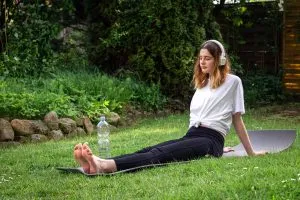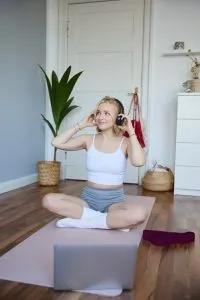If you’ve ever had your hands slip out from under you in downward dog or felt your knees scream in protest during a lunge, you already know—your yoga mat can make or break your practice.
But did you know that the right yoga mat can actually help prevent injuries?
As a yoga instructor with years of teaching (and a few hard-learned lessons), I’ve seen firsthand how choosing the right mat can keep you safe and comfortable while you flow.

Why Your Yoga Mat Matters for Injury Prevention
Picture this: You’re deep in a warrior pose, feeling strong and grounded, when—bam!—your foot slips, and suddenly you’re not so grounded anymore.
A good yoga mat for injury prevention ensures that you stay stable, supported, and cushioned, reducing the risk of falls, strains, and joint pain.
From the right amount of grip to proper cushioning, your mat is your foundation.
Skimping on quality can lead to discomfort and even long-term damage.
And trust me, nothing derails your practice faster than a nagging injury (or the fear of face-planting in front of your entire class).

Non-Slip Yoga Mats for Safety: No More Unexpected Splits
Grip is everything when it comes to preventing slips and slides.
If you’re doing hot yoga or naturally have sweaty palms, a non-slip yoga mat is an absolute must.
Materials like natural rubber and polyurethane provide excellent traction, keeping your feet and hands locked in place—even in the sweatiest flows.
A student of mine, Lisa, used to struggle with slipping so much that she’d bring a towel just to stay put.
After switching to a high-quality non-slip mat, she finally felt stable and could focus on her breath instead of worrying about wiping out mid-warrior pose.

Best Yoga Mats for Joint Support: Protecting Your Knees and Wrists
If your knees, wrists, or lower back ache after practice, your mat might not be offering enough support.
Cushioning in yoga mats for injury prevention is crucial, especially if you practice on hard floors.
Look for mats that strike a balance—too much cushion can make balancing tricky, while too little can be tough on your joints.
As someone who’s had their fair share of knee discomfort (thanks to years of deep lunges and crow pose attempts), I can’t stress enough the importance of a mat with solid joint support.
Mats made from TPE or thick natural rubber tend to offer a great mix of cushioning and stability.

How Yoga Mat Thickness Affects Safety: Finding the Sweet Spot
Yoga mats come in different thicknesses, typically ranging from 1mm travel mats to 6mm ultra-cushioned options.
But how do you know what’s best for you?
- 1-3mm mats: Great for travel and stability but may be too thin for joint protection.
- 4-5mm mats: The sweet spot—provides enough cushioning without sacrificing balance.
- 6mm+ mats: Ideal for sensitive joints but can make balance poses a bit wobbly.
A student of mine once brought a super-thick mat to class, thinking it would be the comfiest option.
Halfway through practice, she was wobbling like a newborn giraffe.
We swapped it out for a medium-thickness mat, and suddenly, her tree pose looked like it belonged in a yoga magazine!

Final Thoughts: Invest in the Right Mat, Thank Yourself Later
Your yoga mat is more than just a piece of gear—it’s your partner in practice.
Whether you need a yoga mat for injury prevention, non-slip yoga mats for safety, or the best yoga mats for joint support, investing in the right one can make all the difference in your comfort and longevity on the mat.
So, if you’ve been making do with a flimsy mat that leaves your knees aching and your feet slipping, do yourself a favor and upgrade.
Your joints (and your confidence) will thank you!





